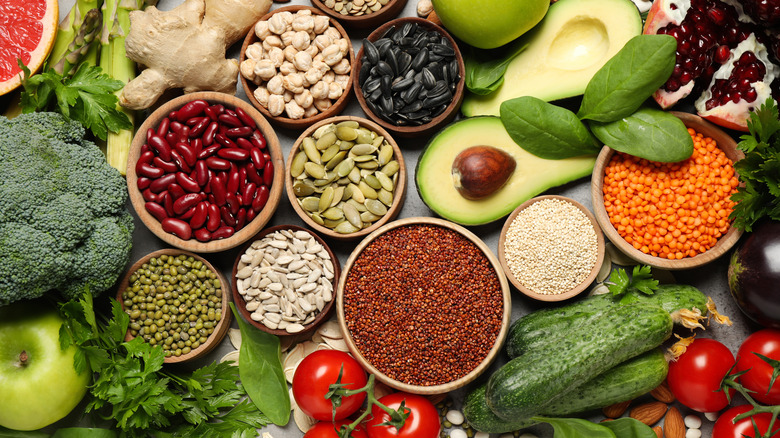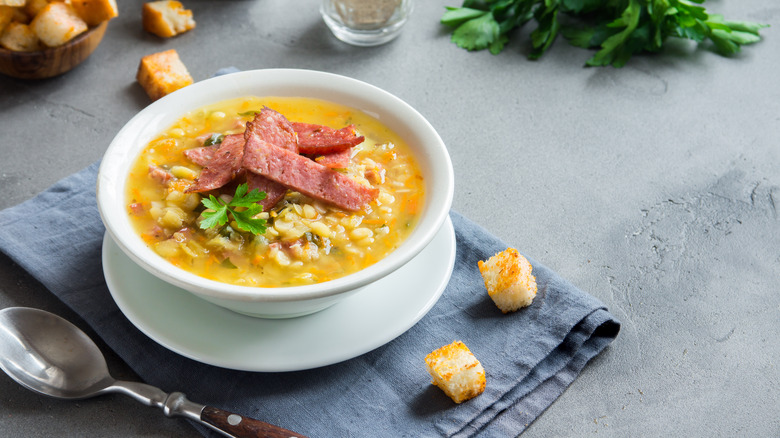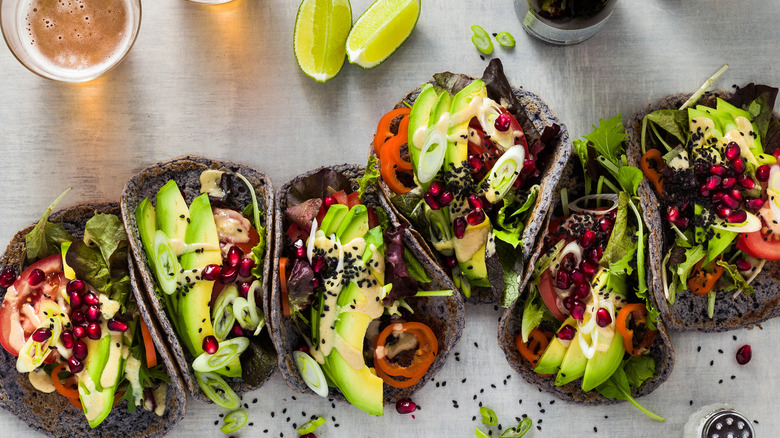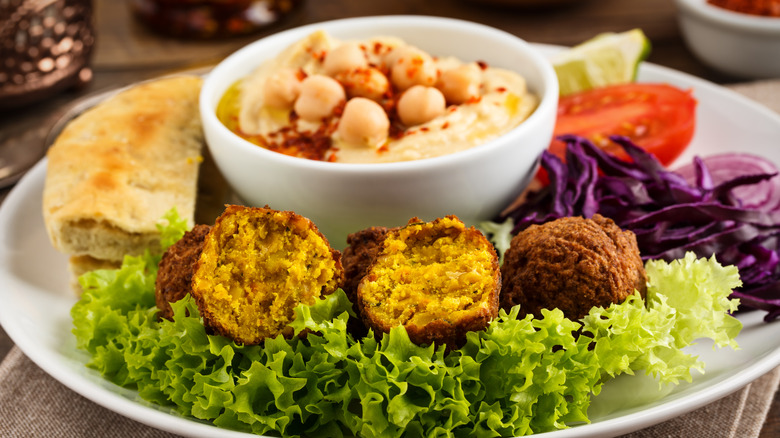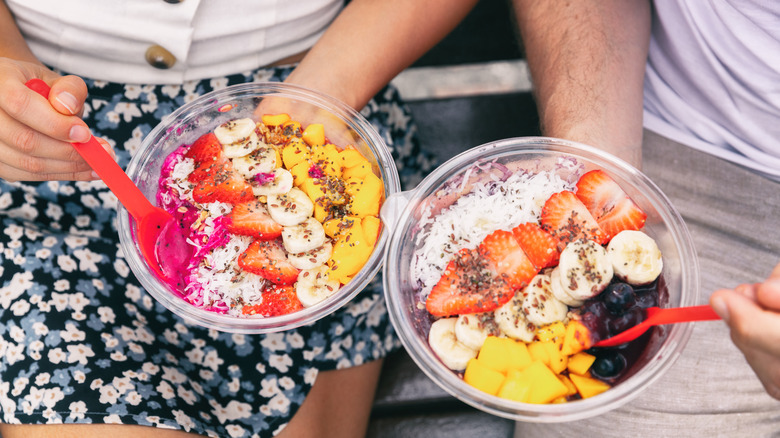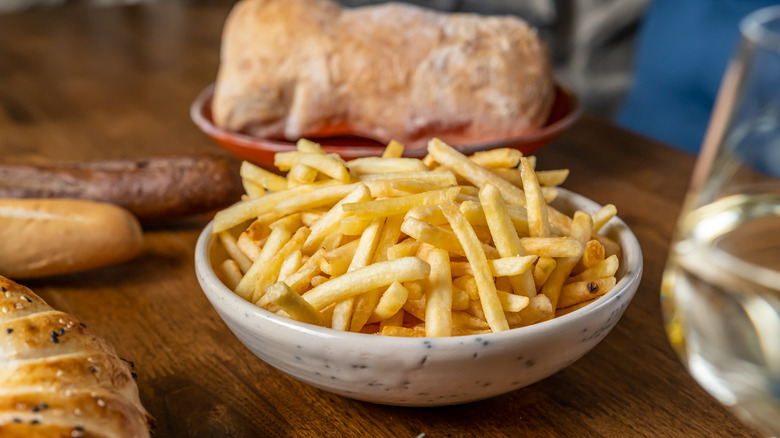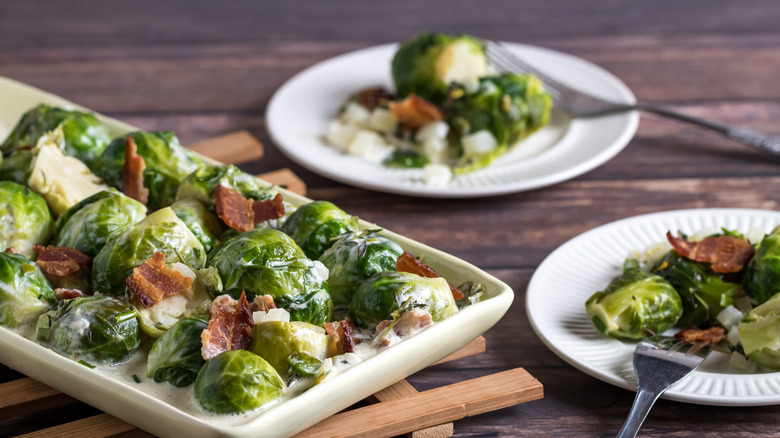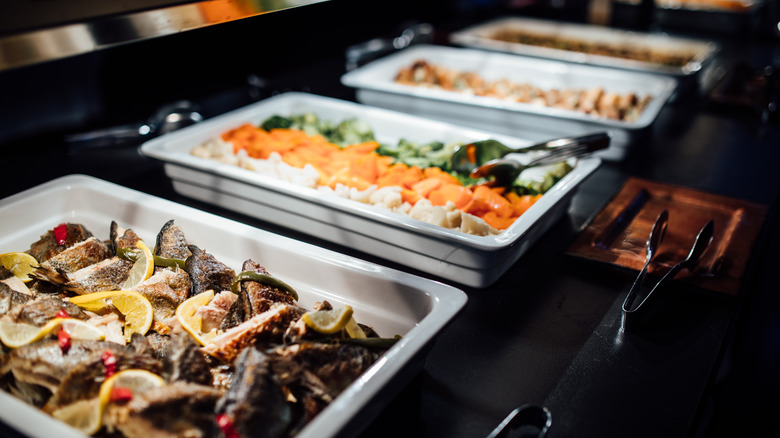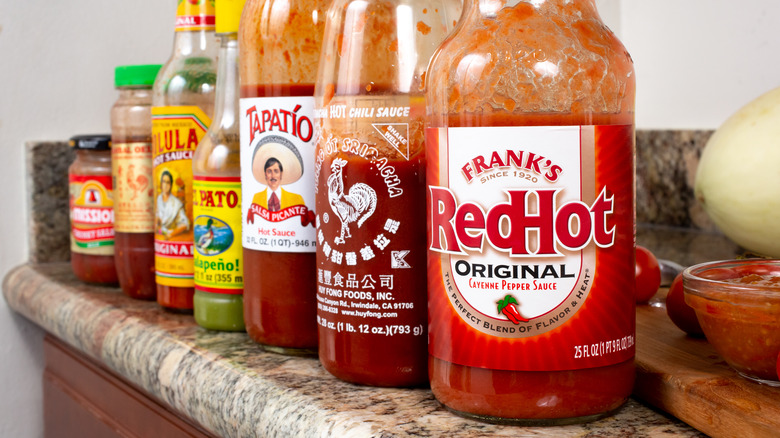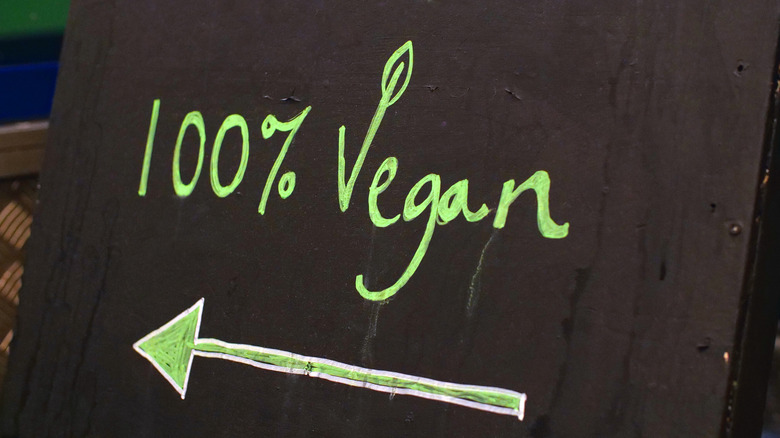Tips For Dining Out As A New Vegetarian
For those who are new to the vegetarian diet, going out to eat can feel like an entirely different experience at first. It's possible that many of your favorite menu items no longer fit into your diet, and it might seem like you don't have any good food options at restaurants. But before you start rethinking things, you should know that there are plenty of tricks to make being vegetarian easier. Many vegetarians have gone through this struggle before, and you can do it too.
Eat Right suggests that taking gradual steps can help make your meatless diet last. Forbes says the same, adding that planning and willpower will be needed to stick with it. If you want to just dive in and get it over with, however, simple changes to how you order and approach going out for a meal can help you in this transition. You'll come to realize that most menu items actually don't have meat, or don't need it, and that there are actually plenty of great things you can still order. This article will go through some of the most useful tricks to make going out to eat as a vegetarian a piece of cake.
Watch out for hidden meat
Those who eat meat don't really have to worry about a dish containing animal parts, but as a vegetarian this can ruin your meal. Sometimes a menu won't list all of the ingredients, so you won't necessarily know ahead of time that something isn't vegetarian. Vegans have a longer list of foods to avoid, including those with egg, dairy or other animal products (via VegKitchen). You'll want to be careful not to order foods that may secretly contain meat, and part of this is just familiarizing yourself with which ones to avoid.
Gravy will often be made with meat broth or even have bits of beef or poultry floating around in it, while baked beans or split pea soup could be hiding pieces of pork. Viva! The Vegan Charity also points out that some stuffings and casseroles could have meat within. Doing a little research using the search term "surprisingly not vegetarian" can help you to avoid accidentally ordering something with meat. You can also always double-check with your waiter before ordering an item you're unsure about so you don't get stuck with something that isn't vegetarian.
Learn to make substitutions
With a little imagination, you'll find most items can be made vegetarian with a simple substitution, and often it isn't too difficult for the kitchen to accomplish. As one example, you can substitute beans or potatoes for the meat in tacos. Most kitchens will have either or both available, and you'll find that the tacos are still excellent even without the meat. Avocados or grilled veggies are also great substitutes for taco meat, and you can always get creative and try different beans or vegetables until you find the perfect filler to suit your tastes. Women's Health Mag suggests tempeh, seitan, jackfruit, and more as other great substitutes for meat. Mushrooms and eggplant can also replace meat well, according to One Green Planet.
Another substitution vegetarians often make is to change their breakfast platters by asking for fruit instead of a side of bacon or ham. If fruit isn't available, many diners and restaurants will let you instead get grits, toast, or extra potatoes instead of the meat. Luckily, there are a lot of breakfast items you can choose from usually, and most restaurants don't mind at all, though they might upcharge you a few dollars depending on what you substitute the meat for.
Check the menu ahead of time
Although many restaurants now offer enough vegetarian items that it's possible to get an entire meal without meat, some still do not. If you want to avoid being stuck with just one option (nobody wants an entire dinner of plain french fries or edamame), you may want to have a peek at the menu before agreeing to a restaurant. Olive Garden sets a great example and lists their vegetarian and vegan items on a handy chart on their website. Most restaurants won't do the same, but at least you can know what you're in for by looking them up before you arrive.
Yelp will allow you to filter for vegetarian food and will show you restaurant options, including ones that are not necessarily exclusively vegetarian but are said to offer great vegetarian options. As Mashed has already covered, there are also a number of fast-food and fast-casual dining options that have good menu items for vegetarians. The point is, your best bet is to get ahead of the game and familiarize yourself with the menu so you don't need to start searching frantically when you get seated.
Ask your waiter for assistance
The people who work at the restaurant probably have some useful insider knowledge about the menu and whether the kitchen staff are likely to be accommodating. They might have suggestions to help you find your perfect vegetarian meal on the menu or know which items can be made vegetarian. There are a number of questions your server can help with, and you may want to inquire whether a sauce or dressing is vegetarian or if an ingredient list is available.
If the waitstaff are working for tips they will be extra motivated to ensure that you have a meal you enjoy, though most people will happily give advice if you just ask nicely anyway. You never know, you might run into a server who is also vegetarian and can tell you how to order the best meat-free dish, whether on the menu or off. Beware though that not all waiters will be helpful, and Readers Digest reveals that some waiters may feel motivated to lie about whether an item is vegetarian if they think the diner won't be able to tell the difference.
Order appetizers and sides
One thing most vegetarians have had to do over the years is get used to the sides section of the menu. You'll find that most sides are vegetarian, and where there may be a dearth of potential entrees that work for your diet, there will probably be some great sides you can feast on instead. Beans and rice, french fries, and chips and salsa are some of the more basic sides you may encounter, but some restaurants offer flavorful asparagus, roasted broccoli, and more. By picking out a few of these items, you can put together a filling meal.
The New York Times points out that for Thanksgiving you can have a full spread without a single dish containing meat. Roasted vegetables, mashed potatoes, collard greens, and vegetarian stuffing are just a few of the side options to fill your plate. US Foods has noted that restaurants are beginning to cater more to vegetarians, in part because of rising meat costs, and also because meat-eaters appear to be cutting back on meat consumption as well for their health. So even if you find yourself in a restaurant with nothing but a few side options, you can take comfort in knowing that more vegetarian dishes are being added to menus every day.
Check out vegetarian restaurants
If your friends are willing to consider eating somewhere without meat, you could ask them to check out vegetarian or vegan restaurants with you. Chances are, they will find something they love, and even appreciate being introduced to something new. Food & Wine notes that flexitarian diets are on the rise, with about one-fifth of U.S. households purchasing meat alternatives. So, it appears that these days even your meat-eating friends may be growing more open-minded towards plant-based choices.
Melissa Clark wrote up a guide for The New York Times about her decision to eat less meat as a response to climate change. Others may be driven by health concerns or compassion for animals, but whatever the reason for any particular person, it seems that plant-based foods are becoming more popular all the time. So take a risk and invite your friends out to try some vegetarian food with you. They'll probably love it, and you'll definitely love having an entire menu to choose from.
Keep your nutrition in mind
Be careful not to get carried away with just ordering junk food once you're vegetarian. Many people seem to think vegetarians are automatically healthy, but it can be just as tempting to opt for sugary, salty, and fatty foods on a vegetarian diet as it is with any other. Much of this can be avoided if you choose to dine at restaurants with a good number of vegetarian options. Of course, if you always meet up at the local sports bar that only has fries and breadsticks to choose from, you're not going to be getting the nutrition you need.
The British National Health Service says these starchy foods are good for providing energy, but should only make up about 30% of your diet. Those fries and breadsticks need to be balanced out with other foods that will provide you with necessary vitamins and nutrients. Remember to include healthy foods often, rather than setting yourself up for trouble by nursing a daily fried food habit.
Request for meat to be removed
Sometimes, making a food item vegetarian is easier than you might think. In addition to substituting vegetarian alternatives for meat, you can also ask for the meat to simply not be added to some dishes. For example, you can probably order that fancy brussels sprouts appetizer without the bacon bits if you just ask nicely. Or, you could order a grilled chicken salad without the chicken.
Often, the solution is as simple as leaving a meat item out of the recipe, and businesses are usually happy to make this change if it is easy for them. They're saving money, and you're not wasting food you would otherwise have picked out. A case study at one restaurant found that vegetarian orders were up by 13% over five years, so don't be surprised if your waiter doesn't even blink when you ask them to hold the meat (via Faunalytics). Chances are, they've had more than a few vegetarians doing the same thing recently.
Figure out your boundaries
With about 5% of adults in the U.S. identifying as vegetarian, according to Gallup, you'll have plenty of company if you choose this diet. But among vegetarians, there is a wide range of ideas about what constitutes a vegetarian diet. Some of the more lax vegetarians only cut meat out of their diets, while others who follow a stricter version of the diet will cut out meat as well as eggs or milk (via Mayo Clinic). Vegans take things a step further by cutting out all animal products. On the other end of the spectrum, flexitarians eat mostly plant-based foods while incorporating a small amount of animal products into their diets.
With all the different ways there are to be vegetarian and vegan, it's up to you to figure out how strict you're willing to be. It also depends on the goals you have in mind, and whether you are following a vegetarian diet for health, the environment, or animal rights. You'll need to decide exactly which foods your diet excludes so that you can confidently order within the guidelines you want to follow.
Prepare for changes to your body
In addition to the positive changes a vegetarian diet may bring you, it could also create some challenges you'll want to prepare yourself for. As an example, your stomach may become sensitive to animal products after cutting out meat, so that even a soup or gravy made with animal stock may not sit well (via Chowhound).
Your digestive system may need time to get used to an all-plant diet, and new vegetarians can experience a period of stomach upset called "the rumbles." According to Vegetarian Times, the rumbles can be overcome by shifting slowly to eating more whole foods, such as legumes and brown rice. Well + Good says that the sudden increase in fiber is the culprit and that drinking more water can help with digestive adjustment.
Even if you have a highly adaptable body, and haven't suffered any consequences so far, it's a good idea to do some research on the foods you should include in your new diet. You'll want to know how much you should be eating of them and what they can do for you (or to you). Being well-informed will give you some control over the process.
Don't moralize or be judgy
Most of us haven't always been vegetarian or vegan, so it's important to remember when dining out with others that the reasons for your choices probably shouldn't be thrown out in conversation unless people ask you to share them. Having an interesting and civil conversation is great over a meal, but you'll lose your friends quickly if you take on a sense of superiority or try to change them.
A BBC article suggests that meat-eaters are forced to rationalize their decision to continue eating meat when faced with mounting evidence against it, and this psychological tension is made worse in the presence of vegans or others who don't eat meat. In other words, it can be uncomfortable to be around people who seem to be doing the right thing when you aren't yourself doing it.
Of course, not everyone agrees with this. ABC News says that many people find vegans and vegetarians to have an off-putting, condescending attitude. Whatever the potential issue, it may be good to skirt it altogether and focus on discussing topics other than food and morality, at least while at the table.
Find a good buffet
Buffets, with their wide variety of food options, are great for vegetarians and meat-eaters alike. It's an easy choice if you're looking for a restaurant that can please even the pickiest eater or someone with a particular diet. As BBC Good Food points out, there are tons of vegetarian foods that are perfect for buffet-style service. Most of the time you can at least find vegetarian pizzas, salads, and sides when you go out to a buffet. Just having more than a couple of options is enough to make a vegetarian feel like they've hit the jackpot, and with all the vegetable appetizers to choose from, there should be plenty to put on your plate.
Delishably advises that you should take it slow at a buffet and be sure to eat anything that you put on your plate, both as a form of buffet etiquette and so you don't waste food. If there is a dessert bar available, remember to save room for that. In general, that is the one buffet area where a vegetarian can eat just about anything.
Bring along your favorite sauce
On occasion, you'll find that a restaurant doesn't have many appealing vegetarian options and may only be able to offer a few veggie sides. If those sides happen to be bland, you'll be wishing you had packed your favorite hot sauce or seasoning. This little flavor hack can elevate the most boring, unseasoned green beans to something delicious. Of course, you're just pouring the flavor you prefer on your food, be it hot sauce or Cajun seasoning, but don't underestimate what a difference this can make. You never know what sauces and seasonings a restaurant will have available, so carrying your own portable version to dinner is simply a way of being prepared.
Stylecaster actually suggests 10 hot sauces you may want to consider having in your bag, à la Beyoncé's famous lyric. There are even "foodie survival kits" that include a number of spices in portable containers. It might seem silly now, but you'll change your mind once you're faced with unseasoned veggies.
Experiment with different cuisines
Once you begin following your vegetarian diet, you might feel that your favorite dishes are now out of reach, but don't despair: Even if you can't eat all the same things as before, you should regard this change as an opportunity for you to find new favorite dishes and cuisines. Many Asian cuisines, such as Thai and Vietnamese food, offer numerous vegetarian options. Mexican food includes a number of delicious meals that don't have meat or can easily be made without it. Some African cuisines, such as Ethiopian, offer great vegetarian entrees and platters. Often these platters are oversized and shareable, making them a great way to introduce others to international vegetarian foods (via Uncornered Market).
Other vegetarian-friendly cuisines include Indian and Mediterranean, according to The Travel. Be sure to try veggie samosas and falafel, if you haven't already. Spoon University suggests that even places like sushi restaurants will usually have good vegetarian options, like edamame and miso soup. So, don't be put off before you try to find foods that work for you. Many different cultures can cater to vegetarian diets.
Look for the leaf or 'V' symbol
One handy way to tell if a food item is vegan or vegetarian is to look for a symbol of a green leaf or the letter "V" next to an item. This usually indicates that it is meatless, the same way a chili pepper symbol might indicate something is spicy. VegWorld Magazine shared that a Smart Protein Project study found 91% of consumers expressed a preference for this type of label to indicate that a food is vegan or vegetarian. Just as it makes it easier in grocery stores to understand what a product contains, a V symbol can make restaurant menus easier for vegetarians to navigate as well.
Eat Right suggests you may want to double-check with a waiter if in doubt about a V symbol on a menu. You can also look for a menu key, usually located on the top or bottom of the menu, which should explain the meaning of any symbols used. If you see the V on a menu at all, it's a good sign that you're going to have at least a few nice options for your meal.
